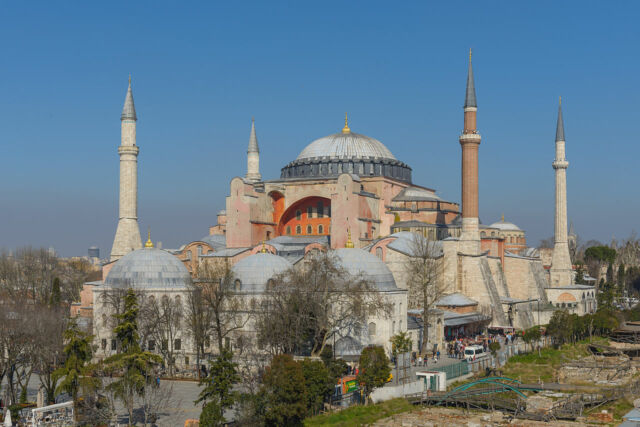The 1,500-year-old Hagia Sophia in Istanbul, Turkey, will become an active mosque beginning on July 24, ending its 85-year run as a secular museum.
Byzantine Emperor Justinian I ordered the building's construction in 532 CE; for nearly 1,000 years, its 55.6 meter (180 ft) dome covered the largest indoor space in the world. Over a millennium and a half, the monumental structure has been an Eastern Orthodox cathedral, a Roman Catholic cathedral, an Eastern Orthodox cathedral again, and then a mosque.
Today, the Hagia Sophia is one of Turkeys largest tourist attractions; an estimated 3.7 million people visited the site in 2019. It became a museum in 1934, under a decree from the Cabinet of Ministers under then-president of the Turkish Republic, Mustafa Kemal Ataturk.
The countrys Cabinet of State repealed the 1934 order this week, following 15 years of legal back-and-forth over the sites status; after the final ruling was issued, Turkish President Recep Tayyip Erdogan issued the order. The first Friday prayer service is scheduled for July 24.
“The Director-General of UNESCO deeply regrets the decision of the Turkish authorities, made without prior discussion, to change the status of Hagia Sophia,” said UNESCO in a July 10 statement. “It is regrettable that the Turkish decision was made without any form of dialogue or prior notice. UNESCO calls upon the Turkish authorities to initiate dialogue without delay, in order to prevent any detrimental effect on the universal value of this exceptional heritage, the state of conservation of which will be examined by the World Heritage Committee at its next session.”
In other words, the eyes of the world will be on whatever happens next.
The Turkish government has stated that, although Muslim religious services will resume at the site, it will remain open to visitors of all nationalities and faiths—much like the Notre Dame Cathedral in Paris, which has been an active Catholic church as well as a major tourist attraction and UNESCO World Heritage Site. Erdogans spokespeople have also stated that Christian iconography inside the Hagia Sophia will continue to be preserved as it has been since the 1930s.
No, you cant go back to Constantinople
Although the change raises serious concerns about the fate of the cultural landmark, its also pretty much par for the course in Hagia Sophias dramatic history, which started a century before the current cathedral was built.
Erdogan, like his predecessor Ataturk, appears to be using the fate of the Hagia Sophia to make a political statement and score some points with his supporters. Their much earlier predecessor, Emperor Justinian I of the Eastern Roman Empire, would probably be nodding in grudging recognition right about now. After all, he ordered the cathedrals construction in the first place for similar reasons.
Justinian hired famed architects Isidore of Miletas and Anthemius of Tralles—along with more than 10,000 workers—to build his grand cathedral in the aftermath of the Nika Revolt, which nearly ended his reign. The Nika Revolt had burned down the cathedral that had previously stood on the site (a few marble blocks with carved reliefs are all that remain today, and theyre mostly buried beneath Hagia Sophia). The cathedral before that one burned down during a revolt in 404.

A new cathedral, bigger and grander than anything else in the world, built atop the one destroyed by a thwarted rebellion, allowed Justinian to make a powerful statement about his… well, power. The Hagia Sophia has always been as much a political landmark as a religious or cultural one—so its not surprising that it has also changed hands, and functions, at least four times in its history.
The Fourth Crusade came galloping into Constantinople in 1204. The crusaders, as crusaders tend to do, ransacked the Hagia Sophia, desecrated it, then declared it a Roman Catholic cathedral instead of an Eastern Orthodox one. In 1261, the Hagia Sophia returned to the Eastern Orthodox Church. Less than 200 years later, in 1453, Mehmet IIs Ottomans came charging into Constantinople (now it's Istanbul, not Constantinople). The conquerors, as conquerors tend to do, ransacked the Hagia Sophia, desecrated it, then declared it a Muslim mosque instead of an Eastern Orthodox cathedral.
In the 1930s, as Turkey became a more secular state, Ataturk turned the mosque into a museum. It was declared a World Heritage site in 1985.
Why did Constantinople get the works?
To understand whats happening now, we have to go back to 1453 CE, the year the Ottoman sultan Mehmet II conquered the city of Constantinople (been a long time gone, Constantinople). He claimed the tremendous domed cathedral at the heart of the city as part of his personal spoils. Shortly thereafter, he included it in a special type of Muslim charitable endowment called a waqf, which he gave to the newly renamed city of Istanbul. In the endowment, Mehmet II specified that the former cathedral was supposed to become a mosque.
In 1934, the Ataturk administration converted the Hagia Sophia from a mosque into a deliberately secular museum. Christian mosaics that had been plastered over in the late 1400s were carefully uncovered, and they shared the domed space with Muslim prayer niches and pulpits. The museums rules actually forbade any religious Read More – Source
[contf] [contfnew] 
arstechnica
[contfnewc] [contfnewc]







